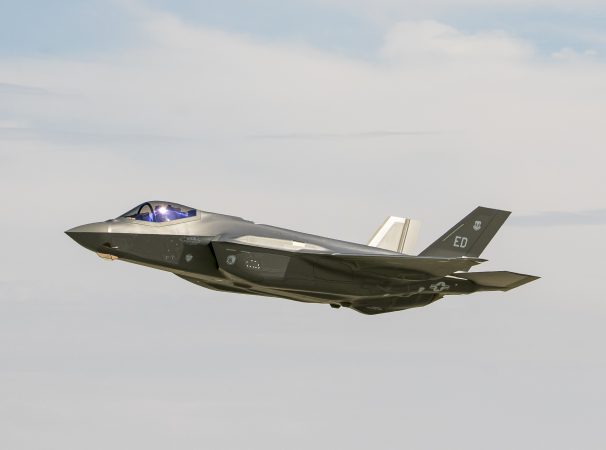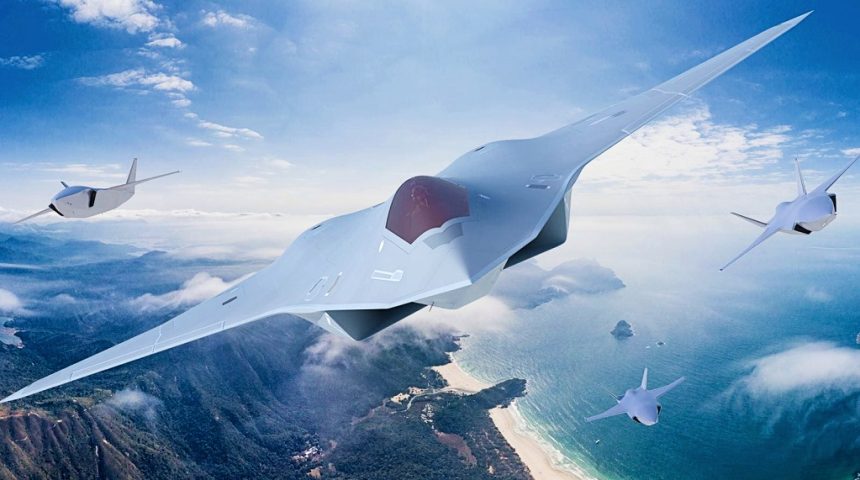Lockheed Martin’s new push for a more powerful F-35—unveiled this week as the company announced it won’t protest the Air Force’s choice of Boeing for the Next-Generation Air Dominance fighter—might largely be the NGAD alternative Air Force leaders from the previous administration were talking about as they deliberated whether to go ahead with what is now known as the F-47.
Last September, former Air Force Secretary Frank Kendall suggested the service might look at “disaggregating” some of NGAD fighter’s sensors and other capabilities to Collaborative Combat Aircraft, USAF’s planned autonomous escorts to the crewed fighter fleet, and shifting to a new, less complex fighter costing about the same or less than an F-35.
Ultimately, the Trump administration decided to move forward with NGAD largely as planned and tapped Boeing to build it—leaving Lockheed Martin, builder of the F-35, on the outside looking in.
In an April 22 earnings call, however, Lockheed president and CEO Jim Taiclet said he believes the F-35 could be upgraded to deliver 80 percent of the NGAD’s capability at half its cost, using technologies developed for the F-22 and the NGAD itself; what he termed a “Ferrari” version of the fighter.
“We have 70,000 engineers and scientists in the company working on really interesting stuff all the time,” Taiclet said. “Some of the fifth-gen-plus solution set is already being funded by the U.S. government and the F-35 program itself.” Secrecy prevented him from being too explicit about what could be done with the F-35 to achieve this capability, but the steps involve “key techniques, I’ll say, and approaches that [the] fighter pilot needs to have to be competitive and win.”
Answering a question about whether the new capabilities would be company- or government-funded, Taiclet said some come from “our government-funded investment in R&D, the competitive process … funded for both Lockheed Martin and Boeing [for NGAD] over a period of years by the government. And, you know, we made independent investments along the way, too, in both” the F-35 and NGAD.
At half NGAD’s projected cost, an upgraded F-35 could be around $150 million per airplane; a price level near what Kendall has said would exceed the affordability that international partners and foreign military sales customers require. Taiclet did not say whether he views the “Ferrari” F-35 as becoming the fleet standard, but did say that engineers are looking at potential upgrades with an eye toward exportability.

What would be different about a fifth-gen-plus F-35? Some of the technologies to consider include:
- Sensors: Taiclet said the need to sense and track an enemy—particularly one that is a stealthy aircraft itself—is necessary “at a distance greater than they can sense you.” Lockheed has developed an infrared search and track system that has been seen on the wings of the F-22 in recent tests. “Passive infrared is really important,” Taiclet said, “because if I’m transmitting radar, that means somebody else’s electronic warfare receiver can see me, and then they can maybe shoot me.” With passive IR, “nobody can sense that. And the best radar on top of those kinds of sensors [is] really, really critical.”
- Extreme Low Observability: Taiclet said he was in a meeting at the White House and the president—he didn’t say which president—said “Dogfights are not what we want anymore,” and Taiclet agreed that “we want to shoot the other guys … even before they know we’re there.” Throughout his discussion of the upgraded F-35, Taiclet referred to using the F-35 “chassis” to host new systems. That might include new wings and control surfaces. The F-35’s planform was designed to make it a good dogfighter, able to turn at 9Gs in the Air Force version and 7.5 Gs in the Marine Corps and Navy models. But if air-to-air maneuvering is less important than greater stealth, the F-35’s high G-loading might be reduced to allow more a more stealthy airframe that would be more of a missile truck than a dogfighter. Taiclet said it would be possible to tweak “materials … geometries [and] countermeasures” to give the F-35 more stealth. That would likely also involve removing the verticals and making the F-35 a tailless design.
- More Powerful Engines: Powerplants already exist to make the Air Force F-35A faster, with better climb and acceleration plus more electricity for sensors and processors. GE Aerospace and Pratt & Whitney developed Adaptive Engine Transition Program (AETP) engines with all of these characteristics, specifically designed to drop into the current F-35. But the Air Force initially elected not to pursue the AETP last year, given that the service would have had to pay to develop them further without help from the Navy or Marine Corps, and adopting them would create at least two engine logistics trains to support the F-35 program, adding sustainment cost.
- Weapons: The highly classified AIM-260 Joint Advanced Tactical Missile—also developed by Lockheed—is in testing and is intended to restore some of the F-22’s “first look, first kill” capability by being able to shoot a stealth target as soon as it is detected. In sufficient quantities, the AIM-260 would be available to equip a large part of the F-35 force and extend its lethal reach.
- Range: The F-22 has been tested with stealthy underwing pylons and fuel tanks that will significantly enhance its range, though how much is a secret. The F-35’s different shaping would probably require different versions of those on the F-22, but the principles should make adapting the concept to the F-35 fairly straightforward.
- Stealthy Communications: Whatever capabilities have been developed to make the NGAD able to send and receive data and voice communications without being detected is likely to be portable to the F-35.
Taiclet said he would not have put forth the concept of the “Ferrari” version of the F-35 if he didn’t believe the concept was achievable.
“My challenge to my aeronautics team is, let’s get 80 percent of sixth-gen capability at half the price,’ he said. “And these engineers … wouldn’t have agreed to this if they didn’t think there was a path to get there.”
However, Lockheed seemingly did not speak with the Air Force before unveiling the concept. At an AFA Warfighters in Action event April 24, Maj. Gen. Joseph D. Kunkel, deputy chief of staff for Air Force Futures, said that he had no discussions with Lockheed on a fifth-gen-plus F-35 and declined to comment further.
The F-35 Joint Program Office, meanwhile, told Air & Space Forces Magazine that it had no comment on the idea, “as the discussion remains entirely notional at this stage.”
Still, Taiclet projected optimism that the Pentagon will embrace the idea: “That’s something we’re going to go out and do. And this is how we get best value to the customer, who has a limited budget and an increasing threat. We use these digital technologies. We apply something from one system, one to another, and we actually try to create that best value equation.”
